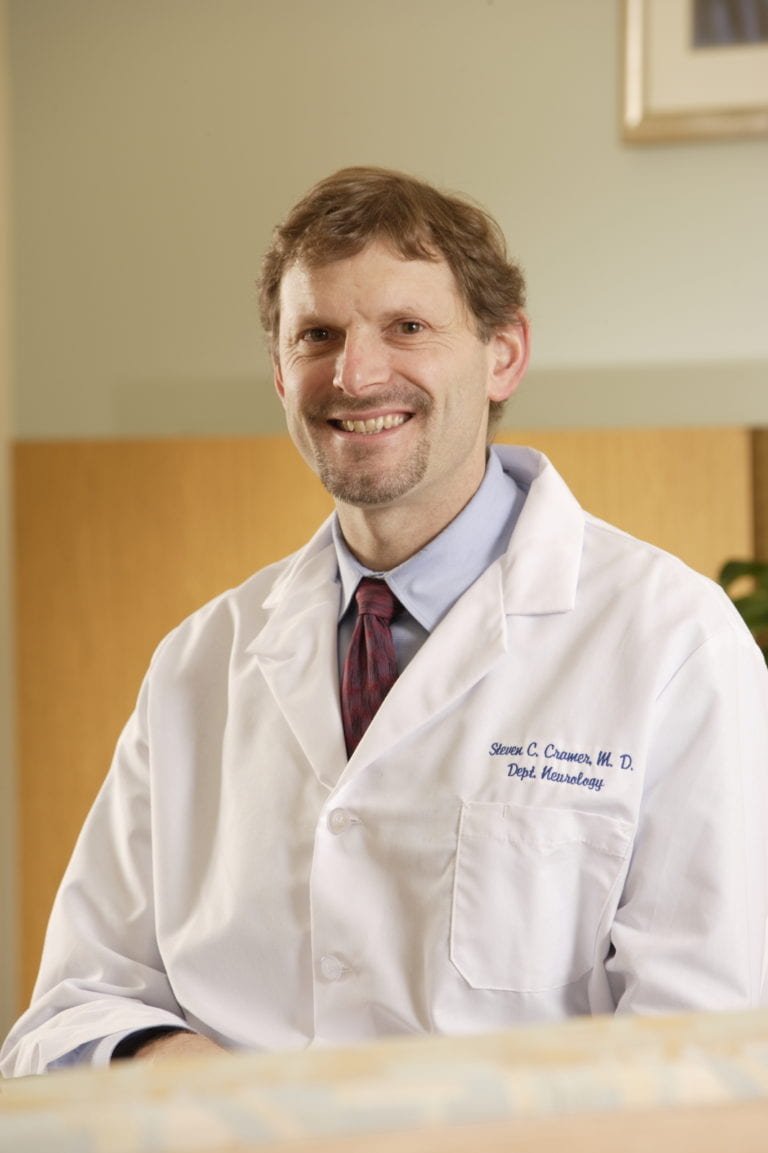To me it shows no such effectiveness. We are talking ineffective in-hospital therapy(not getting 100% recovered) to in-home therapy which is just a bit worse than the hospital. The goal is 100% recovery NOT these dumbed down goals your stroke medical professionals are setting for you. And I've got 9 posts on Dr. Steven Cramer so he is actually one of the good guys, I just disagree on goals for therapy.
UCI study shows in-home therapy effective for stroke rehabilitation
A multisite US clinical trial compared home-based telerehabilitation program with traditional in-clinic rehabilitation therapy
May 24, 2018

Dr. Steven Cramer a professor of neurology in the UCI School of Medicine. UCI Health
Irvine, Calif., May 24, 2018 — In-home rehabilitation, using a telehealth system and supervised by licensed occupational/physical therapists, is an effective means of improving arm motor status in stroke survivors, according to findings presented by University of California, Irvine neurologist Dr. Steven C. Cramer at the recent 2018 European Stroke Organisation Conference in Gothenburg, Sweden.
“Motor deficits are a major contributor to post-stroke disability, and we know that occupational and physical therapy improve patient outcomes in a supervised rehabilitation program,” said Cramer, a professor of neurology in the UCI School of Medicine. “Since many patients receive suboptimal therapy for reasons that include cost, availability and difficulty with travel, we wanted to determine whether a comprehensive in-home telehealth therapy program could be as effective as in-clinic rehabilitation.”
In a study conducted at 11 U.S. sites, 124 stroke survivors underwent six weeks of intensive arm motor therapy, with half receiving traditional supervised in-clinic therapy and half undergoing an in-home rehabilitation program supervised via a videoconferenced telemedicine system.
Subjects were on average 61 years old, 4.5 months post-stroke, and had moderate arm motor deficits at study entry. When examined 30 days after the end of therapy, subjects in the in-clinic group improved by 8.4 points on the Fugl-Meyer scale, which measures arm motor status and ranges from 0 to 66, with higher numbers being better. Subjects in the telerehab group improved by 7.9 points, a difference that was not statistically significant.(But still a COMPLETE FAILURE OF 100% RECOVERY! The only goal in stroke!)
“The current findings support the utility of a computer-based system in the home, used under the supervision of a licensed therapist, to provide clinically meaningful rehab therapy,” Cramer said. “Future applications might examine longer-term treatment, pair home-based telerehab with long-term dosing of a restorative drug, treat other neurological domains affected by stroke (such as language, memory, or gait), or expand the home treatment system to build out a smart home for stroke recovery.”
He said that the demand for rehabilitation services will likely increase, due to an aging population and increased stroke survival as a result of better access to advanced acute care. Telehealth, defined as the delivery of health-related services and information via telecommunication technologies, can potentially address this growing unmet need.
“We reasoned that telerehabilitation is ideally suited to efficiently provide a large dose of useful rehab therapy after stroke,” said Cramer, whose research team is part of the NIH StrokeNet consortium.
This research builds on the findings of a pilot study of 12 patients with late subacute stroke and arm-motor deficits who were provided 28 days of home-based telerehab program. The results, published in November 2017 in the journal Neurorehabilitation and Neural Repair, found that patient compliance was excellent (97.9 percent) and participants experienced significant arm-motor gains (Fugl-Meyer scale increase of 4.8 points). The study also found that patients did not need any additional computer skills training due to the design of the telerehab system.
“Getting patients to remain engaged and comply with therapy is a key measure of success of any rehabilitation program,” Cramer said. “Greater gains are associated with therapy that is challenging, motivating, accompanied by appropriate feedback, interesting and relevant. Telerehab achieves this because therapy is provided through games, provides user feedback, can be adjusted based on individual needs, is easy to use – and is fun.”
This study was supported by the Eunice Kennedy Shriver National Institute of Child Health & Human Development as well as the National Institute of Neurological Disorders and Stroke (grant U01 NS091951), the NIH StrokeNet Clinical Trials Network, the 11 U.S. enrollment sites, the research team at the primary study site at UC Irvine, and the patients and families who participated.
About the UCI School of Medicine
Each year, the UCI School of Medicine educates more than 400 medical students, as well as 200 doctoral and master’s students. More than 600 residents and fellows are trained at UC Irvine Medical Center and affiliated institutions. The UCI School of Medicine offers an M.D. degree, a dual M.D./Ph.D. medical scientist training program, Ph.D.s and master’s degrees in anatomy and neurobiology, biomedical sciences, genetic counseling, epidemiology, environmental health sciences, pathology, pharmacology, physiology and biophysics, and translational sciences. Medical students also may pursue an M.D./M.B.A. program, a combined M.D./Master’s in public health or a dual M.D./master’s program called the Program in Medical Education for the Latino Community. UCI School of Medicine is accredited by Liaison Committee on Medical Accreditation, and ranks among the top 50 nationwide for research. For more information, visit: som.uci.edu.
About the University of California, Irvine
Founded in 1965, UCI is the youngest member of the prestigious Association of American Universities. The campus has produced three Nobel laureates and is known for its academic achievement, premier research, innovation and anteater mascot. Led by Chancellor Howard Gillman, UCI has more than 30,000 students and offers 192 degree programs. Located in one of the world’s safest and most economically vibrant communities, UCI is Orange County’s second-largest employer, contributing $5 billion annually to the local economy. For more on UCI, visit www.uci.edu.
No comments:
Post a Comment